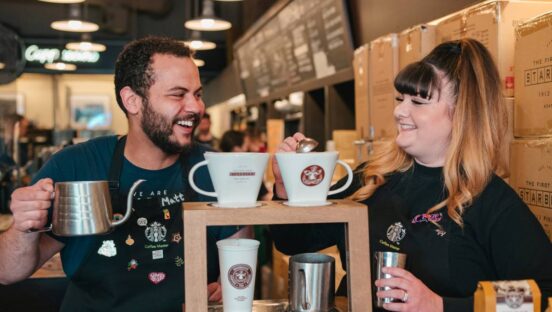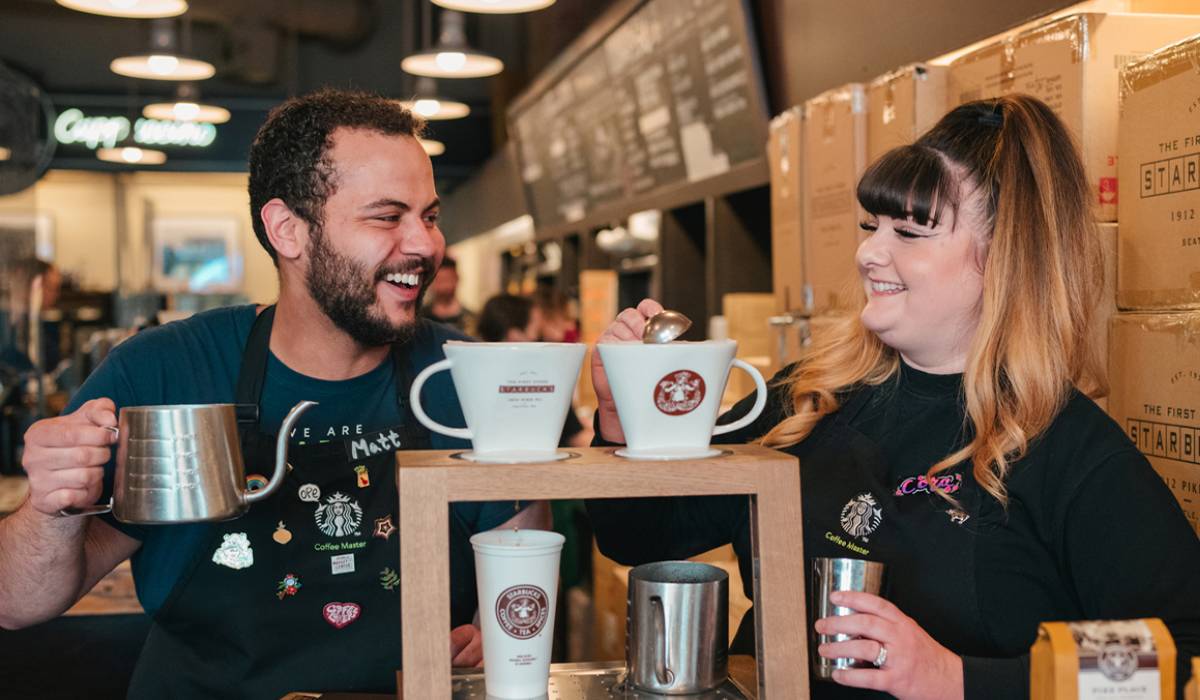With each COVID wave’s retreat, Starbucks has seen consumer demand strengthen, CEO Kevin Johnson said. And the coffee chain anticipates a similar jolt once omicron abates. But guest response and top-line sales aren’t what’s pressing Starbucks of late—the brand delivered record Q1 revenue of $8.1 billion as U.S. same-store sales climbed 18 percent, including a 12 percent increase in transactions.
Instead, it’s “extraordinary cost pressure,” Johnson noted Tuesday in a conference call. The latest COVID variant pushed higher-than-expected price tags in three key areas of Starbucks’ U.S. business.
One was staffing shortages in the supply chain, which upped distribution and transportation costs. The variant’s spread also triggered a “significant increase” in Starbucks’ COVID isolation pay (more employees were out sick or quarantining). Lastly, broader labor challenges, only accentuated by recent conditions, led to Starbucks spending more on training and onboarding than initially planned.
The impact is far from a Q1 blip, either. While operating margins lifted to 14.6 percent from 13.5 percent, the figure missed company expectations and resulted in Starbucks guiding lower profits for the remainder of the calendar. In all, the chain projects omicron’s setback to drag margins by roughly 200 basis points.
“Like most economists,” Johnson said, “we anticipate supply chain disruptions will continue for the foreseeable future.”
Starbucks took pricing action in October and this past January. Additional hikes are expected through the balance of 2022, Johnson said.
Starbucks was enjoying a record holiday quarter, North America Group president and COO John Culver added, before Omicron pulsed in the last two to three weeks of the quarter, which ended January 3. Customer mobility absorbed a hit, call-outs increased, and Starbucks found itself, as mentioned, opening the coffers for COVID pay.
READ MORE: Why value is going to make a fast-food comeback, and why that’s good news for Starbucks
Yet external realities didn’t sour trends that Culver feels will last well past omicron’s prevalence. Cold beverages now account for 70 percent of Starbucks’ beverage transactions. All dairy products are growing. Food is snapping all-time records, anchored by breakfast and bakery. Peak transactions also improved quarter-over-quarter and on a year-over-year basis. Average ticket grew 6 percent in North America.
However, it’s the nature of Starbucks’ agility—both in its real estate and how it gets food to guests—where a changing consumer has reshaped the brand.
Mobile order and pay, drive-thru, and delivery accounted for more than 70 percent of Starbucks sales in Q1. Drive-thrus posted their fourth straight period of double-digit comps growth.
Fifty-three percent of U.S. spend in company-operated stores flowed through Starbucks Rewards members, with the company’s 90-day active membership reaching 26.4 million—21 percent higher than this time last year. In just Q1, Starbucks tacked on 1.6 million members, a cohort that, on average, visits the brand triple the amount of non-rewards users. The chain saw Starbucks Card activations and reloads in excess of $3 billion, also a high mark in brand history. “As part of that, their growth in terms of spend has grown commensurately,” Culver said. “We’re seeing significant increase in the spend in the first year of membership versus the prior 12 months of the preceding membership. We’re seeing a strong lift in spend when they join, regardless of whether the customer is high or low frequency.”
Also, there’s a balancing taking shape as on-premises traffic remains depressed from pre-virus levels. Starbucks’ COVID response has always leaned on flexibility, from the ability to adjust operating protocols, flip to pickup-only setups, drive-thru-only, and other models where people simply don’t walk through the door anymore. The tangible ability for customers to come inside is not at the level of capacity it was before COVID, Culver said. And it’s hard to guess when that changes.
“This is an area that we’re continuing to focus on in adjusting and reopening the stores fully, No. 1, as we’re able to, given COVID; and No. 2, as we’re able to, given some of the staffing challenges that we’ve seen,” he said.
“… Now, in terms of customers and their changing routines and how much is going to go back to where it was before and how much has changed, we feel confident that given the Starbucks experience, our customers come to us because they love a great premium experience in a high-quality cup of coffee,” Culver continued. “And whether it is coming in our stores or coming through the convenience channels, we’re going to continue to grow in all those areas and meet the change whatever it is for our customers going forward in terms of their routines.”
Returning to cost concerns, Starbucks experienced a rapid increase, Johnson said, in supply chain costs related to distribution and transportation as third-party delivery providers faced omicron-related staffing shortages of their own. This hurt the chain’s ability to fulfill a portion of its distribution needs and forced it to “greatly increase” the use of a far pricier spot market, as well as alternative delivery solutions to meet the demand mentioned earlier.
In turn, supply chain-driven inflationary costs, which began to pick up in December, impacted Starbucks’ domestic business by more than 170 basis points on margin in Q1. It’s only going up (to 200 basis points).
Price will be the first counter, and Starbucks will hardly be alone there. A recent Black Box Intelligence webinar poll showed 25 percent of operators planned to take 4 percent or more in price in 2022. Eighteen percent expect to lift 3–3.9 percent; 11 percent 2.1–2.9 percent; and 13 percent less than 2 percent.
Statics back the movement. The food away from home index rose 6.5 percent in December year-over-year, the largest increase since January 1982. The previous 40-year high came in November, when inflation was 5.8 percent. Quick-service meal prices jumped 8 percent, while full-service menu items lifted 6.6 percent.
“There are many factors that contribute to our thoughtful pricing strategy, including the increasing U.S. inflation rate currently running at 7 percent or perhaps greater, as well as wage, customer demand and other costs,” Johnson said. “Second, the rapid spread of omicron through the U.S. required us to quickly adapt store protocols.”
On that latter note, Johnson believes Starbucks’ elevated COVID isolation and vaccination pay will continue through Q2 before moderating in the back half of the year.
To help offset the expense of that projection, Starbucks is “taking the necessary measures” to reduce spending in discretionary areas of its U.S. P&L, Johnson noted. For example, the strong consumer activity suggests Starbucks can tighten G&A expenses. Namely, cut back promotional spend and marketing.
Johnson also called the battle for talent in today’s labor climate, where some 4 million Americans have not yet returned, “notable.” It’s why Starbucks is writing a $1 billion check to boost partner wages and hours, announced last quarter. This will unfold in stages: By summer 2022, the company will offer a starting wage of at least $15 per hour for store-level workers, making good on a promise from December 2020. Come January, employees with two or more years tenure will receive up to a 5 percent raise and those with five or more years will see wages lift 10 percent. Overall, Starbucks said hourly U.S. employees are set to make an average of nearly $17 an hour with baristas taking in $15–$23.
Starbucks experienced its share of staffing issues in Q1, Johnson said, which led directly to the kickback on higher training costs. The brand said last quarter, over the prior 12 months, 70 percent of its hourly employees were new to Starbucks. The chain has adjusted labor models and store hours at times to address hurdles. It’s also continuing to work on efficiencies, like reducing low-volume SKUs, as it did during the first COVID surge, and adding equipment, like warming ovens, cold brew systems, and Mastrena 2 machines.
“What we’ve done with the actions that we’ve taken as we emerged out of the quarter, we’re beginning to see that turnover rate stabilize,” Culver said. “And basically, our hourly turnover rate has … flattened over the course of the last several weeks. In addition to that, we’ve also seen a significant uptick in terms of partner sentiment, which is improving as well. So for us, we are an employer of choice.”
CFO Rachel Ruggeri believes staffing-related costs will moderate as these investments translate into higher retention.
“In terms of elasticity, we have not seen any meaningful impact to customer demand,” Culver said of higher prices. “To the contrary, our customer demand continues to grow.”








